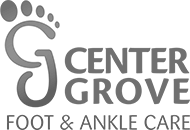.jpeg) Hammertoe
Hammertoe
Hammertoe can be seen when one or both of the joints of the second, third, fourth, or little toes are fixed in a bent position. This abnormal bending puts pressure on your toes, especially when wearing shoes, which can cause many different problems. These are some common symptoms of hammertoes:
- Pain or irritation of the toe when wearing shoes.
- Corns (a buildup of skin) caused by the constant friction of the toe rubbing in the shoe. These may be soft or hard and can appear on the top, side, or end of the toe.
- Calluses (a different type of skin buildup) on the bottom of the toe or on the bottom of the foot.
Hammertoes may also become painful due to the joint itself becoming dislocated. If left untreated, hammertoes will become more rigid and will not respond to nonsurgical treatments. Because hammertoe will only get worse over time, it is important to receive early treatment.
Nonsurgical Treatments
- Trimming corns and calluses – This trimming should always be done by professional, so do not attempt to do this on your own.
- Padding corns and calluses – A podiatrist can provide pads to help protect corns and calluses from irritation.
- Change of shoe-wear – Shoes that are too short, have pointed toes or high heels should be avoided.
- Orthotic Inserts – Custom orthotic shoe inserts can help to better support your feet.
- Injections – Injections of corticosteroids can be helpful in decreasing pain and inflammation caused by hammertoe.
- Medications – Drugs such as ibuprofen can be used to reduce pain and inflammation.
- Splinting/Strapping – Splints or straps can be used to help realign the bent toe.

